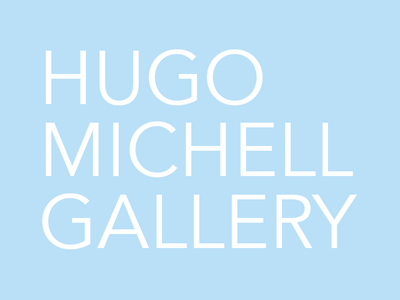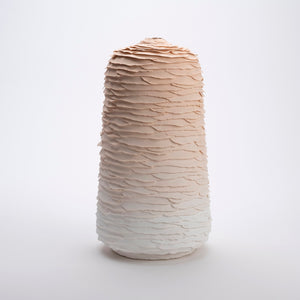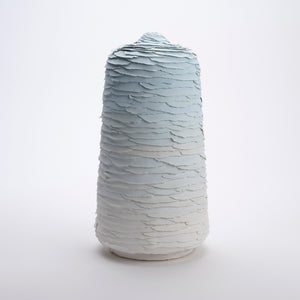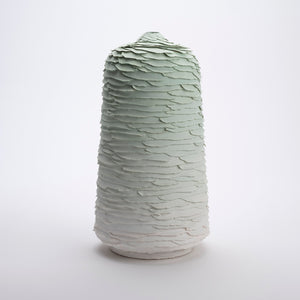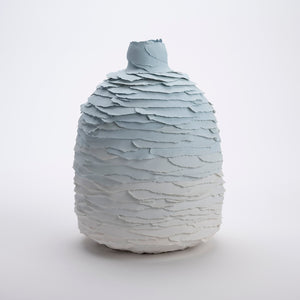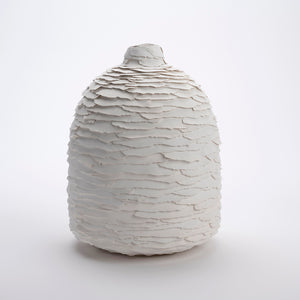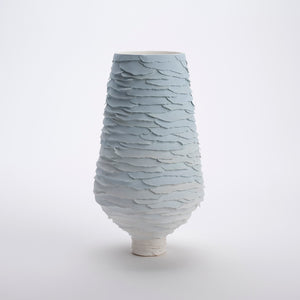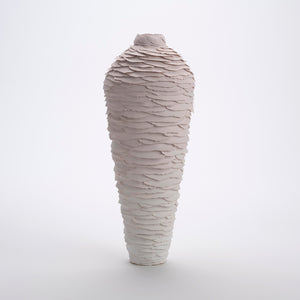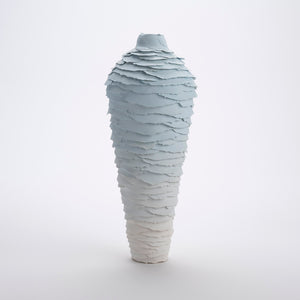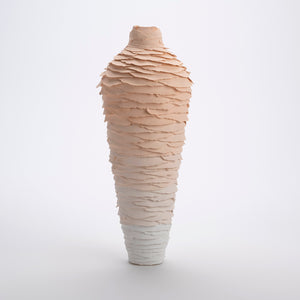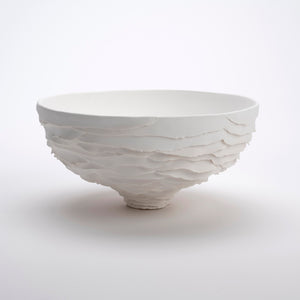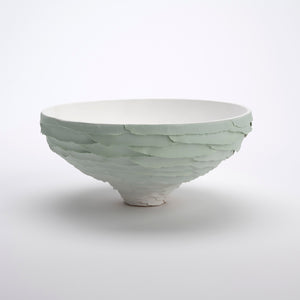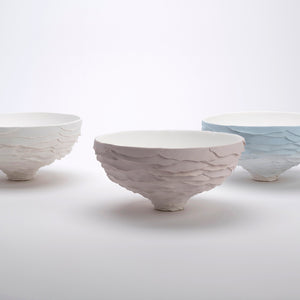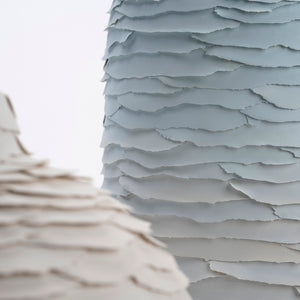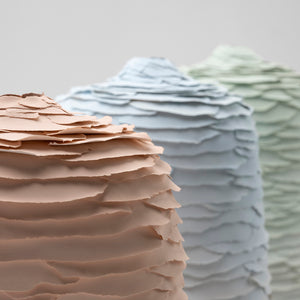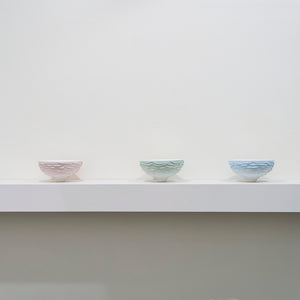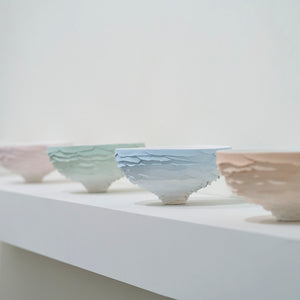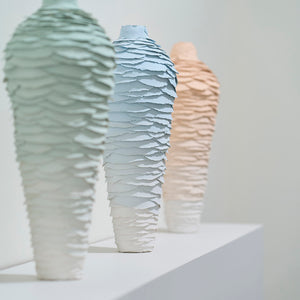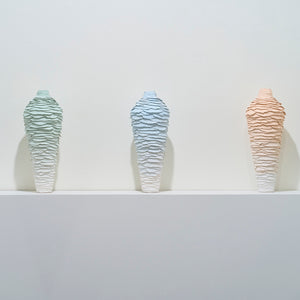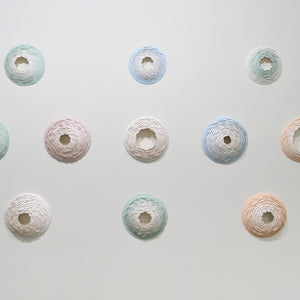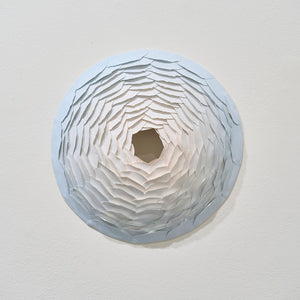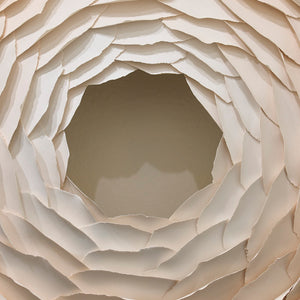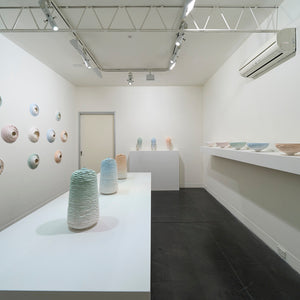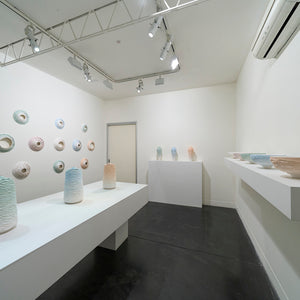Ellis Moseley HEIST
20 April to 20 May 2023
Artist Statement
Heist presents an experimental and conceptual project that features exquisitely formed ceramic vessels and wall pieces. Whilst valuing the important aesthetic considerations of the object, this exhibition is part of Moseley’s ongoing research to test the limits of what an artwork can be.
Each vessel and wall piece are covered in wafer-thin overlapping petals of paper-clay slip. Thin layers of slip are painted onto a plaster bat, peeled away and then applied to the body of each vessel.
These labour intensive and technically intricate objects perform a dual function, firstly to be enjoyed as objects, without stated meaning, then, if the viewer chooses, to introduce the central idea of Moseley’s endeavours, the artwork accompanying the object.
The time and energy put into making the vessels is representative of the amount of research, thinking and planning that has gone into the conceptual aspects of the project. Moseley has gained advice from the Philosophy and Law Faculties at Flinders University, where he is currently undertaking his honours degree in Fine Art, to examine the validity of claiming someone else’s consciousness or mind as his artwork.
This work is part of a trajectory in art history whereby the definition of art has been broadened. Moseley has been influenced by the work of artists such as Marcel Duchamp, Piero Manzoni and Yves Klein, who made everyday objects and materials or even the human body their artwork. In this case, Moseley is extending these notions to claim the consciousness of individuals as his artwork.
Moseley’s consciousnesses are paired with the vessels in the gallery. The vessels themselves are not considered by the artist to be the work, but simply an anchor for the artwork, a physical object that accompanies the metaphysical artwork. Functioning much in the same way a church or temple does as a physical place for the consideration of metaphysical (non-physical) things.
Moseley’s broader practice seeks to draw attention to social concerns through symbolic and conceptual gestures that encourage a deeper consideration of our own attitudes and behaviour. This project endeavours to highlight that our consciousness or inner awareness is innate, common to all beings, and central to our existence. It is a defining characteristic of our humanity. Understanding and accepting that others have an awareness like our own is unifying and central to empathy. Oppression through systematic dehumanisation is driven by delineating the perception of others’ or groups’ inner awareness from one’s own, lessening it justifies the absence of empathy.
As divisions along ideological lines continue to become amplified, the accompanying tendency to reduce individuals to only their ideology is divisive and dehumanising. Empathy has its genesis with our shared understanding and acceptance of a commonly experienced inner awareness/consciousness.
Moseley’s Heist invites the viewer to examine what it is exactly he is claiming, through examining the nature of their own consciousness/inner awareness and perhaps that of the person standing next to them in the gallery.
Essay by Professor Jakob Hohwy
Close your eyes for a moment and think of that moment, perhaps a nice Sunday morning, when you wake from a dreamless sleep and the buzzin’ bloomin’ confusion of consciousness kicks in. All of a sudden you are you, feeling, sensing, thinking, perceiving. The breeze from the open window caresses your skin, you hear the birds, see the curtains flutter in the wind. With consciousness there is something it is like to be you. Turning on a computer, even a sophisticated chatGPT engine, doesn’t do any of those things – there is nothing it is like to be it.
Science does not know what the brain basis of consciousness is. We know consciousness depends on the brain, but we don’t know how. Our ignorance is so extraordinary that philosophy opens the door for consciousness being something over and beyond the physical processes in the brain. In a naturalist worldview, such dualism is implausible but the metaphysical jury is out on consciousness.
With Moseley’s work, we question exactly this relation between the material world and consciousness. What is it for a consciousness to be here or there, or anywhere, or perhaps (gasp!) everywhere? How do we cogently speak about, let alone conceive, a phenomenon that is so utterly private that only you truly know your own consciousness, leaving you to more or less shakily infer the consciousness of others from their behaviour?
Despite its ephemeral nature, consciousness is a surprisingly hands-on resource and commodity; we can almost literally feel the pain of others, theatre’s tragedy and comedy swing your consciousness wildly, and social media monetises it. Art can immerse consciousness, washing out the boundaries to the world, or it can make us painfully aware of the lonely nature of the self, and, as Ellis Moseley’s delicate nonwork does, question the very nature of consciousness.
Moseley’s first works of nonwork, The Work is not the Work, in the collection of Monash University’s Centre for Consciousness and Contemplative Studies (M3CS) is a philosophical exploration beautifully apt for a research centre like ours , dedicated to philosophy and consciousness science. Having it as the centre piece triggers profound conversations among us and with every new visitor. To us, it is also an act of defiance – a metaphysical heist – clawing consciousness back from the tech moguls who are so busy stealing ours. Are tech moguls now mere zombies, fully functional but the lights are out on the inside? How would one know? The philosopher wonders – can you steal someone’s consciousness from them in their dreamless sleep?
What would it be to regain the consciousness that the distractions in life tear from us, dimming our lights each waking moment? Does it make sense to say we can become more conscious? What would that be like, and what would it take? Moseley’s empty vessels are for us daily reminders for contemplation; for increasing attention to and amplifying the conscious experience of the present moment, for cultivating capacity to better notice what dims or sharpens the lights in our conscious lives. They are sentinels of consciousness helping us forge more conscious connections to ourselves and those around us.
Next Sunday as you wake up, give yourself a few more seconds to stay in the moment, let your attention to your stream of consciousness briefly shield you from the to-dos of the day; then wonder how what it is like to be you right there and then can also be a material thing, an information process in the brain.
Funny how a thing that is not a thing can have such impact.
Professor Jakob Hohwy is Director for the Centre for Consciousness and Contemplative Studies and Professor of Philosophy
Ellis Moseley’s first ‘Consciousness’ works, exhibited at Linden New Art, Victoria, in January 2022 are on permanent display at Monash University’s Centre for Consciousness and Contemplative Studies M3CS.
Thought Law | Essay by Margaret Davies
Much of the everyday world as we experience it appears to be beyond legal notice. But appearances, as the saying goes, can be deceiving. Consider thoughts. It might appear that the law is not unduly concerned with your thoughts. Is this really the case? Pure thoughts, without action, cannot at present be seen by law. But as soon as there is action, the law might be very interested in what you are thinking and/or what a reasonable person might be thinking. For instance, in criminal law, the more serious criminal offences require proof of both action and intention, your insanity might be a defence, and psychotherapy to change your thoughts might be part of a post-conviction treatment plan. In different times and places, your quite ordinary sexual conduct with another consenting adult might have attracted legally endorsed conversion ‘therapy’. As soon as your thoughts are expressed as words or images, they might attract scrutiny through laws relating to defamation, vilification, misleading and deceptive commercial conduct, copyright, privacy, official secrecy, and so on. Law might also be interested in whether you have capacity to make certain decisions at all. On the whole though, rather than try to control or judge your thoughts, in liberal societies law aims to protect your ability to think (and believe) as you please. For instance, it might stop you from downgrading the ability of others to be independent in their thoughts – if you are engaging in coercive control or bullying of another person, law might step in to protect their self-esteem and mental health. Even in this context there are limits. How far should law go in protecting you from (for instance) misinformation and/or cults?
In order to have thoughts you need to be conscious. But how, if at all, does law understand your consciousness? Your consciousness is your own unique way of forming a coherent world. Removed from you, it cannot be your consciousness. Neither object nor subject, neither material nor entirely immaterial, and emerging through many connections with human and nonhuman others, it appears to defy definition. Your reputation and, in earlier times, your honour might provide an analogy. But reputation is more clear-cut than consciousness because it can be evidenced – what do other people think of you? Reputation can be easily impugned, for instance by a defamatory statement. Your consciousness is altogether more problematic. Is it a thing that the law can grasp in some way?
For instance, do you own your consciousness and can it be taken from you? In order to own a thing legally (to have property in it), it needs to be separate from a self; it needs to be an object. Although the notion of self-ownership is culturally resonant, it is absent from property law, not because you lack autonomy but because ‘ownership’ and ‘property’ are not apt concepts for your self-relation. Nonetheless, self-ownership crystallises with creative outputs, which become your property, once they are no longer you. Physical artefacts that you made become commodities that can be sold. Your original intellectual outputs may also be protected by rights that can be owned and sold, as copyrights, patents, trademarks (etc). Such outputs must be capable of being materialised and replicated, normally as near-identical copies of a form. Such objects are hylomorphic – made material according to an immaterial template.
All of these categories – intention, thought, conscience, intellectual property, artworks, reputation, autonomy – touch on consciousness but never quite capture it. They may echo through a work that the artist has made of my consciousness, but do they grasp it? Do I?
Professor Margaret Davies is the Matthew Flinders Distinguished Professor, College of Business, Government and Law.
_____
This exhibition has been supported by the Helpmann Academy through a Creative Development Grant awarded to Ellis Moseley.
